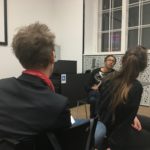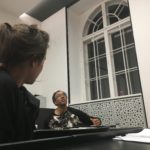Material Sounds
organized by Kristina Pia Hofer, Eva Kernbauer, Marietta Kesting
Thursday, 07th December 2017
16:00 – 19:00
In this workshop, we want to invite you to discuss the mobility of sounds in locally specific music and sonic artworks: their movement across borders, nations, cultures and formats, as well as their mobilizing effects in aesthetic, political, social/affective and economic realms. We are interested in how the materiality of sounds shapes and influences such movements and exchanges: how do (subcultural) sounds materialize both locally and globally? Which media formats become important, which obsolete – and where? for whom? why? What can such materializations tell us about the tension between the promise at the heart of digitalization (namely, a seemingly unlimited fluidity of sound across formats and geographies), and the realities of late global capitalism, which often keep an unequal distribution of (material and immaterial) resources firmly in place?
We will also be interested in the entanglements of human audiences and “technical support” (Krauss 1999): Do human bodies that produce (play equipment) or embody sounds (dance) become part of a machinistic assemblage or a cyborg? What modes of perception and experience are prevalent? Is there pleasure in experiencing oneself as “a music-machine,” for example? What experiences and trajectories may materialize for racialized and otherwise othered subjects, whose histories of exchanging and engaging with sound may not be part of canonical knowledge? What could be a viable, ethically sound “future perfect mode” (Harrasser 2016, 204) to think through such histories and futurities?
In the last two decades sound art has become increasingly prominent in installations that offer sonic experiences not only in galleries but also in public spaces (like clubs). This shows a significant shift: from sound performances working in a strict temporal setup (e.g. a concert) to the sonic as a performance without a clear script (or a clear beginning and end), which invites audiences to engage with sound as a spatial as well as a temporal phenomenon. But while sound art has proliferated, the materiality of sound seems underresearched. We thus want to discuss and think through several different approaches to sonic materiality. We may address semiotic and significatory frameworks that see historical sensibilities transcribed in the aesthetics of popular musical genres (cf Taylor 2001), and contrast them to ‘new materialist’ and media archeologist ideas, which trace the sonic as materially tied to the computational logics and electronic currents of its storage and transmission technologies (cf Cox 2010, Ernst 2016). Furthermore, we may investigate the integrative takes that listen to the “sound of technology” (Birtwistle 2010, 85-125) in dialogue with the historical and contingent – that is, ever changing – circumstances of (human) production, transmission and reception, and that locate sonic materiality in the in-between (cf Kelly 2009); or affective approaches that find sound materialized in the listening and dancing bodies of humans, often in connection to surrounding space (cf Oliveros 2005, Garcia 2015). Last but not least we want to consider recent formats of sound storage like the MP3, which according to Jonathan Sterne are “ubiquitous and banal technolog[ies]“ but nevertheless „offer[…] an inviting point of entry into the interconnected histories of sound and communication in the twentieth century“ (Sterne 2012, 2).
Which of these theoretical approaches can best describe the qualities of the exchange, storage and travel of musical sounds in the examples discussed in Uproot (Jace Clayton 2016)? Is it best to combine several perspectives, and if so, in which way? Can we even speak of a “material politics of sound”? To which concepts of historicity and temporality could such politics connect? How do we need to distinguish sonic/musical materialities from the specific materiality of images and film that we have worked on in our earlier workshops?
With Jace Clayton, Kristina Pia Hofer, Marietta Kesting and Shilla Strelka.
In cooperation with the Academy of Fine Arts Vienna, Kammerspiele Munich and Kampnagel Hamburg.
Universitiy of Applied Arts Vienna
Oskar Kokoschka-Platz 2
1010 Wien
Auditorium 1





